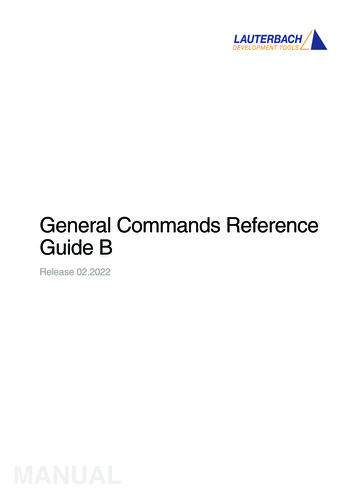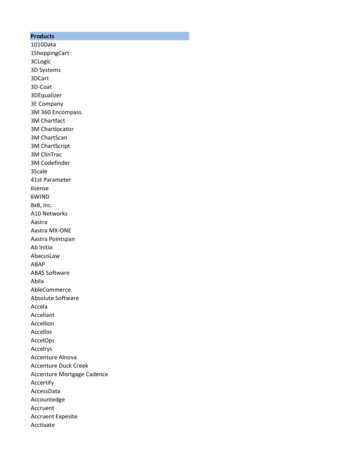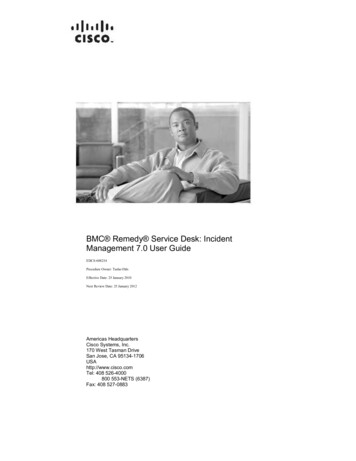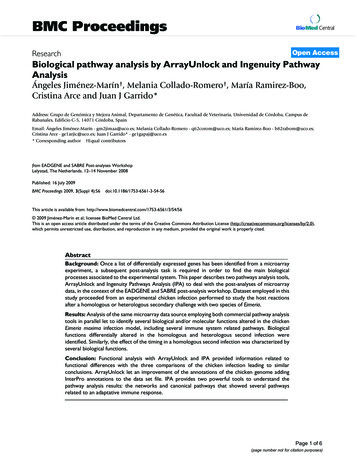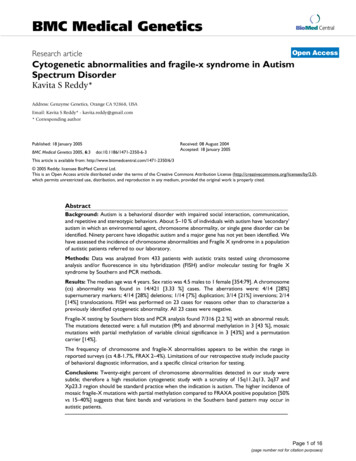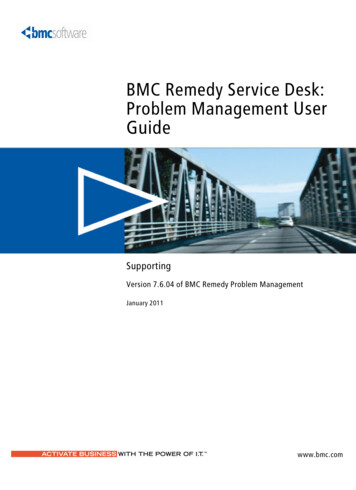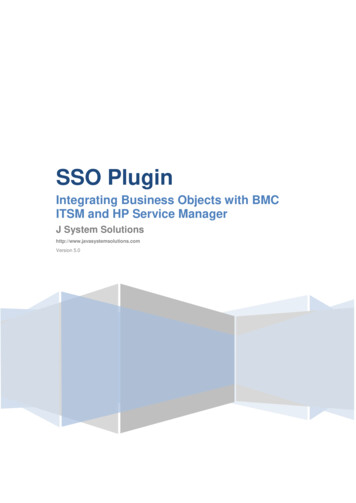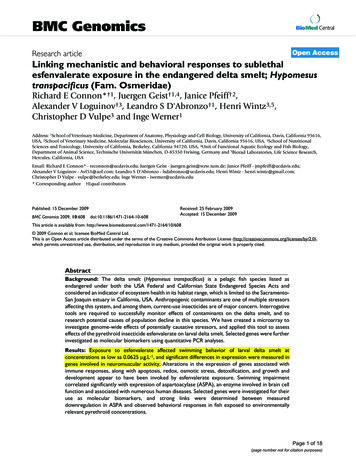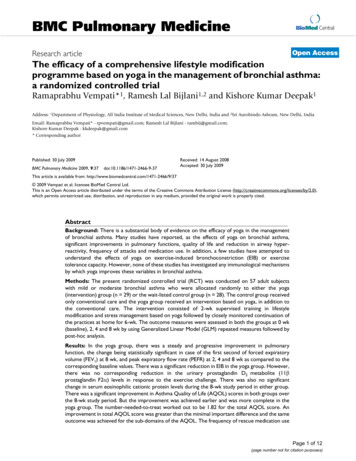
Transcription
BMC Pulmonary MedicineBioMed CentralOpen AccessResearch articleThe efficacy of a comprehensive lifestyle modificationprogramme based on yoga in the management of bronchial asthma:a randomized controlled trialRamaprabhu Vempati*1, Ramesh Lal Bijlani1,2 and Kishore Kumar Deepak1Address: 1Department of Physiology, All India Institute of Medical Sciences, New Delhi, India and 2Sri Aurobindo Ashram, New Delhi, IndiaEmail: Ramaprabhu Vempati* - rpvempati@gmail.com; Ramesh Lal Bijlani - rambij@gmail.com;Kishore Kumar Deepak - kkdeepak@gmail.com* Corresponding authorPublished: 30 July 2009BMC Pulmonary Medicine 2009, 9:37doi:10.1186/1471-2466-9-37Received: 14 August 2008Accepted: 30 July 2009This article is available from: http://www.biomedcentral.com/1471-2466/9/37 2009 Vempati et al; licensee BioMed Central Ltd.This is an Open Access article distributed under the terms of the Creative Commons Attribution License (http://creativecommons.org/licenses/by/2.0),which permits unrestricted use, distribution, and reproduction in any medium, provided the original work is properly cited.AbstractBackground: There is a substantial body of evidence on the efficacy of yoga in the managementof bronchial asthma. Many studies have reported, as the effects of yoga on bronchial asthma,significant improvements in pulmonary functions, quality of life and reduction in airway hyperreactivity, frequency of attacks and medication use. In addition, a few studies have attempted tounderstand the effects of yoga on exercise-induced bronchoconstriction (EIB) or exercisetolerance capacity. However, none of these studies has investigated any immunological mechanismsby which yoga improves these variables in bronchial asthma.Methods: The present randomized controlled trial (RCT) was conducted on 57 adult subjectswith mild or moderate bronchial asthma who were allocated randomly to either the yoga(intervention) group (n 29) or the wait-listed control group (n 28). The control group receivedonly conventional care and the yoga group received an intervention based on yoga, in addition tothe conventional care. The intervention consisted of 2-wk supervised training in lifestylemodification and stress management based on yoga followed by closely monitored continuation ofthe practices at home for 6-wk. The outcome measures were assessed in both the groups at 0 wk(baseline), 2, 4 and 8 wk by using Generalized Linear Model (GLM) repeated measures followed bypost-hoc analysis.Results: In the yoga group, there was a steady and progressive improvement in pulmonaryfunction, the change being statistically significant in case of the first second of forced expiratoryvolume (FEV1) at 8 wk, and peak expiratory flow rate (PEFR) at 2, 4 and 8 wk as compared to thecorresponding baseline values. There was a significant reduction in EIB in the yoga group. However,there was no corresponding reduction in the urinary prostaglandin D2 metabolite (11βprostaglandin F2α) levels in response to the exercise challenge. There was also no significantchange in serum eosinophilic cationic protein levels during the 8-wk study period in either group.There was a significant improvement in Asthma Quality of Life (AQOL) scores in both groups overthe 8-wk study period. But the improvement was achieved earlier and was more complete in theyoga group. The number-needed-to-treat worked out to be 1.82 for the total AQOL score. Animprovement in total AQOL score was greater than the minimal important difference and the sameoutcome was achieved for the sub-domains of the AQOL. The frequency of rescue medication usePage 1 of 12(page number not for citation purposes)
BMC Pulmonary Medicine 2009, wed a significant decrease over the study period in both the groups. However, the decreasewas achieved relatively earlier and was more marked in the yoga group than in the control group.Conclusion: The present RCT has demonstrated that adding the mind-body approach of yoga tothe predominantly physical approach of conventional care results in measurable improvement insubjective as well as objective outcomes in bronchial asthma. The trial supports the efficacy of yogain the management of bronchial asthma. However, the preliminary efforts made towards workingout the mechanism of action of the intervention have not thrown much light on how yoga worksin bronchial asthma.Trial registration: Current Controlled Trials ISRCTN00815962BackgroundAlthough the efficacy of yoga in treating bronchialasthma[1] has been investigated since at least the 1960s[2-9], most of the previous studies have been uncontrolled, and have evaluated only a few selected yogic postures or breathing exercises. To the best of our knowledge,there is only one randomized controlled trial which hasevaluated the efficacy of an integrated package consistingof yogic postures, breathing exercises, cleansing techniques, meditation, devotional sessions and lectures[10].However, even this study did not investigate the mechanisms by which yoga improves the symptoms of bronchial asthma. The present randomized controlled trial wasundertaken to study the efficacy of a comprehensive lifestyle modification and stress management program basedon yoga in subjects having mild or moderate bronchialasthma. An attempt has also been made to monitor someimmunological indicators of severity of disease and mastcell activation.MethodsSubjectsThe subjects were adult patients having mild or moderatebronchial asthma who were either referred to the IntegralHealth Clinic (IHC) of the All India Institute of MedicalSciences (AIIMS) by AIIMS physicians or came to IHC inresponse to our advertisements in local dailies.The potential subjects went through a step-wise screeningprocedure. The inclusion criteria consisted of (1) age 18years or older; (2) an established diagnosis of mild-tomoderate asthma for at least 6 months (meeting theAmerican Thoracic Society[11] spirometry criteria formild-to-moderate asthma, which requires either a forcedexpiratory volume in 1 second [FEV1]/forced vital capacity[FVC] below the lower limit of normal with a significantresponse to a bronchodilator [a 12% increase and a 200mL absolute increase in FEV1 15 minutes after the administration of 2 puffs of a short acting β-agonist] or peakexpiratory flow rate [PEFR] variability 20%); (3) takingat least one of the following: inhaled β-agonists, methylx-anthines, anticholinergics, inhaled corticosteroids; and(4) stable medication dosing for the past month. Subjectswere excluded if they (1) smoked currently (or in the pastyear) or had a smoking history of greater than 5 packyears; (2) had a concomitant lung disease; (3) were takingleukotriene inhibitors or receptor antagonists, or mastcell-stabilizing agents for at least 6 months; (4) practicedyoga or any other similar discipline during 6 months preceding the study; (5) were pregnant; (6) had a chronicmedical condition that required treatment with oral orsystemic corticosteroids in the past month; (7) had a medical condition that contraindicated exercise; or (8) had anunstable medical condition.Of the 138 potential subjects screened, 66 did not meetthe above-described eligibility criteria. Of the 72 eligiblesubjects, only 60 were included in the study at the end ofthe 1-week run-in period and the other 12 subjects wereself-withdrawn before randomization. The subjects completed the baseline measurements of all the outcomeparameters after randomization. These 60 subjects wererandomly allocated to either the yoga (intervention)group (n 30) or the wait-listed control group (n 30).However, one subject in the yoga group, and two subjectsin the control group discontinued midway in the study.The results presented in this report are based on the datacollected from only the 57 subjects who completed thestudy (yoga group, n 29; control group, n 28).Experimental DesignThe present study is an open-label randomized controlledtrial (RCT) with two parallel groups. The control groupreceived conventional care whereas the experimentalgroup received, in addition to conventional care, an intervention based on yoga. The subjects from both groupswere on bronchodilators in the form of inhalers orinhaled corticosteroids depending on the judgment of thetreating physician. None of the subjects was on systemicor oral corticosteroid therapy. However, subjects were notallowed to change their inhaled corticosteroid dose during the study period. During the study, the control groupPage 2 of 12(page number not for citation purposes)
BMC Pulmonary Medicine 2009, 9:37was offered a session on health education relevant to theirillness, and at the end of the 8-wk study period, the intervention based on yoga. The outcome measures wereassessed in both groups at 0 wk (baseline), 2, 4 and 8 wk.The subjects in neither group were encouraged to eitherdelay or reduce their rescue medication use, but wereinstead advised to consult their treating physician for anydose changes, if required.Treatment InterventionParticipants assigned to the yoga group underwent a comprehensive yoga-based lifestyle modification and stressmanagement program for 4 hours a day for 2 weeks. Thesessions were conducted from 8 am to 12 noon. The subjects were neither unemployed nor disabled. Their abilityto spend that much time in the clinic might be due to 'cultural differences'. In India, the patient respects his therapist and is willing to do whatever it takes to comply withthe prescribed treatment. Corresponding to this attitude,the employer is also willing to bend the requirements ofthe job to make it possible for the employee to get thetreatment. If the patient is a homemaker, other membersof the extended family are willing to pitch in with childcare and other essential tasks to enable the patient to getthe treatment. The program consisted of lectures and practical sessions on asanas (postures), pranayamas (breathing techniques), kriyas (cleansing techniques),meditation and shavasana (a relaxation technique). The4-hour sessions included asanas and pranayamas for 1hour; breakfast and building up of group support for 30min; lecture and discussion for 2 hours and meditationfor 30 min. The yoga practice sessions were conducted bya qualified yoga instructor. The lectures were on yoga, itsplace in daily life, its application to stress management,fundamentals of nutrition and health education relevantto their illness. Each subject received at least one sessionof about one hour of individualized counseling. Duringthese individualized counselling sessions, the subject'squestions regarding yogic practices, diet, prognosis, testresults etc. were answered. In addition, family and socialhistories of the subjects were taken to establish a goodrapport, and to discover any major mental stress, real orperceived, which might be aggravating the disease. In caseof mental stress, some counselling, primarily in the formof cognitive restructuring based on the spiritual philosophy underlying yoga, was attempted. The counselling wasdone by physicians with special interest in yoga andmind-body medicine.The physical practices consisted of elementary breathingexercises and loosening exercises followed by asanasunder four categories (standing, sitting, prone andsupine), pranayama, kriyas, and meditation based on rajayoga. Participants were instructed to follow a specificbreathing pattern during each asana and asked to h pose in final position for up to 30 sec without holding their breath. Soothing instrumental music was playedwhile the participants were practicing the yoga techniquesto induce relaxation. Participants practiced yogic postureswith awareness focused on their physical movements andbreath. Each posture was followed by an appropriaterelaxation technique for a short period. The classes concluded with deep relaxation in shavasana for about 15min followed by guided imagery for about 5 min. Theyoga practice sessions were about one and a half hour during the 2-wk training period and additional 6-wk homepractice. The level of compliance for yoga practice wasassured at least 5 days a week. The content of the dailyhome practice sessions was the same as during the 2-wktraining, i.e. one hour of asanas and pranayama, 10 minof relaxation and 20 min of meditation. Subjects wereprovided printed material and audiocassettes to supplement live instruction. The yoga group subjects' compliance during the follow-up period was monitored by adiary on their adherence to yoga practice, dietary adviceand rescue medication use, which they filled in everydayand brought during each visit. An individual yoga practicesession was offered to the subjects during study evaluationvisits. The control group was also asked to keep a diary ofmedication use and was attended by their treating physicians during study evaluation visits. During the follow-upperiod, telephonic support was also provided for motivating participants to improve their compliance.The diet recommended for the yoga group was predominantly vegetarian; it mainly consisted of a combination ofcereals and pulses, preferably unrefined; moderateamounts of judiciously chosen fat; moderate amounts ofmilk and milk products; moderate amounts of spices; vegetables and fruits about 500 g, vegetables being predominantly of the leafy green variety, and at least some eatenraw (uncooked).Outcome measures and techniques of measurementThe outcome measures were spirometric indices of pulmonary function, eosinophilic cationic protein as amarker of the course of the disease[12]; the degree of exercise-induced bronchoconstriction, urinary concentrationof the prostaglandin D2 metabolite, 11β prostaglandinF2α before and after the exercise challenge as a marker ofmast cell activation, quality of life and frequency of rescuemedication.Spirometric indices of pulmonary functionThe indices of interest, viz. forced vital capacity (FVC),forced expiratory volume in the first second of expiration(FEV1), the ratio FEV1/FVC, peak expiratory flow rate(PEFR) and average forced expiratory flow rate during theexpulsion of 25–75% of FVC (FEF25–75%) were measuredby computerized spirometric equipment (K4b2, COS-Page 3 of 12(page number not for citation purposes)
BMC Pulmonary Medicine 2009, 9:37MED srl, Italy). The FVC manoeuvre was repeated at leastthrice during each measurement. The highest of threeacceptable readings of FVC and FEV1 were taken as the values for that sitting.Eosinophilic cationic protein (ECP)The serum concentration of ECP was assessed by sandwich ELISA kit (MBL ECP ELISA kit, Japan, code No. 7618E). The coefficients of variation for inter-assay and intraassay measurements were 10.7% and 11.1% respectively.Exercise-induced bronchoconstriction (EIB)The exercise challenge was given using a stationary bicycleergometer (Bodyguard 990, Sandnes, Norway). Theworkload was fixed at 80–85% of the maximum predictedheart rate while pedalling at 60 revolutions per min. Thesubjects were told to go on till they reach the limit of theirdyspnoea or inability to continue the exercise for any reason. The duration of the exercise in different subjectsranged from 3–7 min. The heart rate was monitored continuously through a remote sensor attached to the subject's chest (Polar Electro Inc., Finland) and displayed ona computer screen. The exercise was performed in an airconditioned room with ambient temperature between 24and 27 C, and relative humidity between 40 and 50%.Thus the environmental conditions under which exercisewas performed at different sittings were comparable. Thedegree of EIB was measured as highest degree of exerciseinduced change in FEV1 from 0 min (baseline) to 3, 8, 15and 30 min post exercise.Urinary 11β prostaglandin F2α (11β-PGF2α)Urine was collected 5 min before exercise and again 30min after the end of exercise. Urine samples were stored,without the addition of any preservatives, at -20 C untilanalysis. The concentration of 11β-PGF2α excretion wasestimated by using Enzyme Immuno Assay (EIA, CaymanChemical, Ann Arbor, MI, USA; Catalog No. 516521). Theinter-assay and intra-assay variations for 11β-PGF2α assaywere 9.7% and 5.5% respectively. To correct for the effectof diuresis, creatinine concentrations were measured forall urine samples by a commercially available colorimetricassay (Wipro Biomed, Bangalore, India), using Jaffe' Ratemethod[13]. Therefore, the urinary 11β prostaglandinF2α concentrations were expressed as picogram per milligram of creatinine[14].Quality of LifeQuality of life was measured by using a self-administeredAsthma Quality of Life Questionnaire (AQOL) which isavailable in bilingual form, i.e. English and Hindi[15].The AQOL is a 32-item disease specific questionnaire thathas been validated to measure the problems that tients with asthma experience in their daily lives[16]and has also been validated on Indian population[17].Subjects responded to each question on a 7-point scale (1being maximum impairment; 7 being no impairment).The overall quality of life score is the mean score of all the32 items. Thus the score may vary from 1–7. The 32 itemsare further grouped into four sub-domains viz., symptoms, activity limitation, emotional function and reactivity to environmental stimuli. The score for each subdomain was also calculated as the mean score for itemspertaining to that sub-domain. Thus, the score for eachsub-domain may also vary from 1–7.Rescue medicationThe subjects were asked at the beginning of the study toadd up how many times they had used a bronchodilatorinhaler during the preceding 2-wk as prescribed by thephysicians. For quantifying subsequent use, the subjectswere told to make a note in their diaries every time theyhad to use rescue medication for getting quick relief fromsymptoms such as wheezing, cough or shortness ofbreath. At any point in time, the frequency of rescue medication was calculated as the average number of times thatthe medication had to be used in a day during the preceding 2-wk.Analysis of dataThe baseline (0 wk) values of each outcome measure werecompared with the values obtained at 2, 4 and 8 wk byGeneralized Linear Model (GLM) repeated measures followed by post-hoc analysis[18]. Categorical variableswere analyzed using Chi-square analysis. Continuous variables were analyzed using Mann-Whitney U test, Friedman test for overall group significance or the independentsample t-test, depending on the distribution of data. Incase of outcome variables which changed in the samedirection in both the interventional and control groups,between-group comparisons were also made to determineif the change in one group was significantly greater thanthat of the other group.The degree of EIB was quantified by the percentage ofhighest fall in FEV1 reached after exercise during post-exercise measurements (3, 8, 15 and 30 min) as compared tothe pre-exercise value. There was very high inter-individual variability in degree of EIB. Therefore the subjects weredivided into exercise-sensitive (ES) and exercise-resistant(ER). Those who had a reduction of 15% or more in FEV1post exercise at 0-wk were considered ES, and the rest ER.The ECP values were log-transformed prior to analysis dueto their wide range. Urinary 11β-PGF2α concentrationsPage 4 of 12(page number not for citation purposes)
BMC Pulmonary Medicine 2009, 9:37were not normally distributed and therefore expressed inmedian and inter-quartile ranges. The percentage changein urinary 11β-PGF2α following exercise was used for statistical analysis.A change of 0.5 in the AQOL score has been consideredthe Minimal Important Difference (MID) as clinicallymeaningful difference[19]. Based on the MID, numberneeded to treat (NNT) was calculated using the methoddescribed by Gyuatt et al., (1998)[20] for trials with a parallel group design.Differences were considered significant if p 0.05. All statistical calculations were performed using the SPSS software 10.0.1 release for Windows (SPSS Inc, Chicago IL,USA).Ethical considerationsThe protocol of the study was approved by the EthicsCommittee of All India Institute of Medical Sciences. Thesubjects signed an informed consent form before beingenrolled for the study and knew that they were free towithdraw from the study at any stage without assigningany reason.ResultsThe demographics and baseline values of outcome variables of subjects are given in Tables 1 and 2. As seen inthese tables, the two groups are comparable at baseline inevery respect except PEFR expressed as percentage of thepredicted value.The values of the outcome measures at different timepoints during the study are given in Tables 3, 4, 5 and 6and Figures 1, 2 and 3.There were no significant changes in pulmonary functionindices in the control group during the course of thestudy. In contrast, there was a steady and progressiveimprovement in the subjects of yoga group during thesame period. The change in the yoga group was statistically significant for FEV1 at 8 wk and PEFR at 2, 4 and 8wk, as compared to the corresponding baseline values(Table 3). In addition, significant group mean differenceswere observed between yoga and control groups over the8-wk study period in PEFR, FEV1, FEV1/FVC and FEF25–75%. In PEFR, since there is a significant baseline difference, baseline was considered as a constant covariate forbetween-group comparisons.There was no significant change in serum ECP levels during the 8-wk study period in either group (Figures 1 and2). The EIB decreased significantly in the yoga group, butnot in the control group over the 8-wk study period (Table4). Subgroup analysis in ES subjects revealed 9/37reduction in EIB over the 8-wk study period in both yogaand control groups but the amount of reduction observedwas more marked in the yoga group than in the controlgroup. In ER subjects the change in EIB was not significantin either group. Similar analysis of percentage change inurinary 11β-PGF2α levels in response to the exercise challenge revealed no significant change during the study ineither group (Table 5). One interesting observation at 4wk in the control group (in ES subjects) was that the EIBwas rather significantly high, and this was associated witha significant increase in urinary 11β-PGF2α excretion inresponse to the exercise challenge as compared to the ESsubjects in yoga group (Tables 4 and 5).The AQOL scores showed an improvement over the 8-wkstudy period in both groups (Table 6). But the improvement was achieved relatively earlier and was more complete in the yoga group. At 2 wk, the improvement wasstatistically significant as compared to the baseline scorein the total quality of life as well as each of the four subdomains in the yoga group, but not in the control group.Even by 8-wk, significant improvement was seen in thecontrol group only in total AQOL and symptoms but notin activity limitation, emotional function or the responseto environmental stimuli. The NNT was found to be 1.82for the total score, 2.41 for symptoms score, 1.66 for activity limitation score, 1.91 for emotional function score and1.70 for the response to environmental stimuli score,which means 2 subjects needed to be treated with yogaplus conventional treatment for one subject to have a clinically meaningful improvement in quality of life over andabove the improvement that the subject would have experienced with conventional treatment alone.The frequency of rescue meditation use showed a significant decrease over the 8-wk study period in both thegroups. But the decrease in rescue meditation use wasachieved relatively earlier and was more marked in theyoga group than in the control group (Figure 3). Rescuemedication use between yoga and control groups was significantly different at 2 and 4 wk because of the remarkable decrease in the frequency of the medication use onlyin the yoga group.Although the level of compliance for yoga practice aimedat was at least 5 days a week, this level could not be sustained throughout the 8 weeks of the study. The compliance for yoga practice as reported by the subject was(average number of practice days per week): Wk 0, 4.6 0.5; Wk 2, 4.6 1.1; Wk 4, 4.5 1.2; and Wk 8, 4.4 1.1.DiscussionThe present study has demonstrated that adding the mindbody approach of yoga to the predominantly physicalapproach of conventional care results in measurablePage 5 of 12(page number not for citation purposes)
BMC Pulmonary Medicine 2009, le 1: Demographics and Baseline Values of Outcome VariablesYoga group(n 29)Control group(n 28)33.5 11.433.4 11.50.96Males, n (%)13 (45)20 (71)0.29Females, n (%)16 (55)8 (29)0.19Weight, kg (mean SD)61.3 11.558.9 9.70.93Height, cm (mean SD)162 10.1161.8 7.40.40Body Mass Index (BMI) (mean SD)23.4 4.322.6 4.00.44Family history of asthma present, n (%)13 (44.8)11 (39.3)0.67Duration of Asthma, years (mean SD)11.6 9.510.5 11.90.2213 (44.8)11 (39.3)0.7816 (55)17 (60.7)0.82FVC (% of predicted)78.7 13.375.2 15.00.35FEV1 (% of predicted)70.2 17.462.5 19.20.11FEV1/FVC (% of predicted)80.4 11.573.7 14.80.06PEFR (% of predicted)68.6 18.457.4 19.70.03FEF25-75 (% of predicted)38.4 14.533.9 18.30.31Serum ECP level (ng/mL)1.32 0.511.25 0.430.89EIB (%fall in FEV1 with EC)15.0 14.09.1 10.80.16Urinary 11β-PGF2α before exercise (pg/mg of creatinine), median � Urinary 11β-PGF2α (pg/mg of creatinine) with exercise challenge, median (IQR)26.9 (7.4–218)38.4 (3.1–108)0.55AQOL total score3.72 1.173.64 1.140.80AQOL symptoms score3.77 1.343.62 1.420.70AQOL activity limitation score3.66 1.133.67 1.170.95AQOL emotional function score3.94 1.473.59 1.390.35AQOL environmental stimuli score3.72 1.174.04 1.420.14Age, years (mean SD)Mild asthma, n (%)Moderate asthma, n (%)p-valueAbbreviations: AQOL, Asthma Quality of Life; FEV1, forced expiratory volume in 1 second; FEF25–75%, forced mid-expiratory flow between 25% and75% of FVC; FVC, forced vital capacity; PEFR, peak expiratory flow rate; ECP, eosinophilic cationic protein; IQR, inter- quartile range; EC, exercisechallenge; EIB, exercise-induced bronchoconstriction; 11β-PGF2α, 11β prostaglandin F2α.p-value obtained by from Chi-square analysis or 't' test or Mann-Whitney U test depending on the type of variables.All values are expressed as mean SD, except ECP expressed as log-transformed values and 11β-PGF2α as median with inter-quartile range.Page 6 of 12(page number not for citation purposes)
BMC Pulmonary Medicine 2009, le 2: Daily dose of inhaled corticosteroids and rescue medication at baselineType of medicationYoga(No. of subjects)Control(No. of subjects)p-valueMean inhaled steroid dose, μg/day(mean SD)§320.4 158.8(n 17)360 151.4(n 15)0.48Rescue medication use (puffs/day) 2.27 1.5(n 26)1.98 2.09(n 20)0.19§ Daily dose of inhaled steroids in beclomethasone μg equivalents over the past 1-2 wk.These were calculated on the assumption that beclomethasone 2000 μg budesonide 1600 μg fluticasone 1000 μg. Rescue medication Inhaled rescue bronchodilator intake (puffs/day) use per day and an average for 2 weeks preceding the study visit.p-value obtained from Chi-square analysis or Mann-Whitney U test.improvement in some subjective as well as objective outcomes in bronchial asthma. There have been previousRCTs on the efficacy of yoga which have arrived at similarconclusions[3,6,10]. But none of the previous trials havegone into the plausible mechanisms by which yoga mighthelp bronchial asthma even in a small way as the presentstudy has done. Since the major built-in differencebetween the two groups was the yogic intervention during8-wk of the study, any difference in the outcome is likelyto be due to yoga. The control being a wait-listed group, itdoes not control completely for non-specific effects of theexperimental intervention such as expectation, belief, subject investment in time and effort, change in the subjects'daily routine, investigator interaction, social interactionand support, and placebo effect.The 8-wk duration of the yogic intervention was an arbitrary compromise. It is long enough to demonstrate theeffect, but the ideal would be a much longer study. However, in practice the decline in compliance increasessteeply as the study gets longer, possibly owing to the timecommitment required from the subjects[9]. Since there isno appropriate placebo possible for yoga, the subject cannot be blinded. The allocation of the subjects to the twogroups was randomized, but the selection of subjects fromthe patient population was not random. Every subjectwho made it to our clinic to volunteer for the trial wasalready convinced in his mind about the beneficial effectsof yoga because of its popularity in India. This is an inherent flaw of such trials, and limits the extrapolation ofresults to the entire subject population. However, this lim-Table 3: Results of pulmonary function indices during the studyParameterGroupWeek 0Week 2Week 4Week 8PEFRYoga68.6 18.476.5 20.5*81.5 20.9‡85.3 20.7‡Control57.4 19.758.2 22.056.9 26.256.2 22.0Yoga70.2 17.473.9 19.676.1 20.177.9 17.2*Control62.5 19.263.1 20.560.5 21.659.9 19.1Yoga78.7 13.478.0 12.679.3 13.082.2 10.7Control75.0 15.074.7 18.373.4 18.172.5 17.5Yoga80.4 11.582.6 13.383.7 13.483.1 12.2Control73.7 14.974.8 13.972.4 15.173.3 13.8Yoga38.4 14.642.0 19.445.0 20.545.0 19.7Control34.0 18.333.8 17.832.4 18.131.1 .0110.035All values are % of predicted and expressed as mean SD.* p .05; † p .01; ‡ p .001 based on post-hoc pair wise comparisons with 0 wk values.p
BioMed Central Open Access Page 1 of 12 (page number not for citation purposes) BMC Pulmonary Medicine Research article The efficacy of a comprehensive lifestyle modification programme based on yoga in the management of bronchial asthma: a randomized controlled trial Ramaprabhu Vempati* 1, Ramesh Lal Bijlani1,2 and Kishore Kumar Deepak
